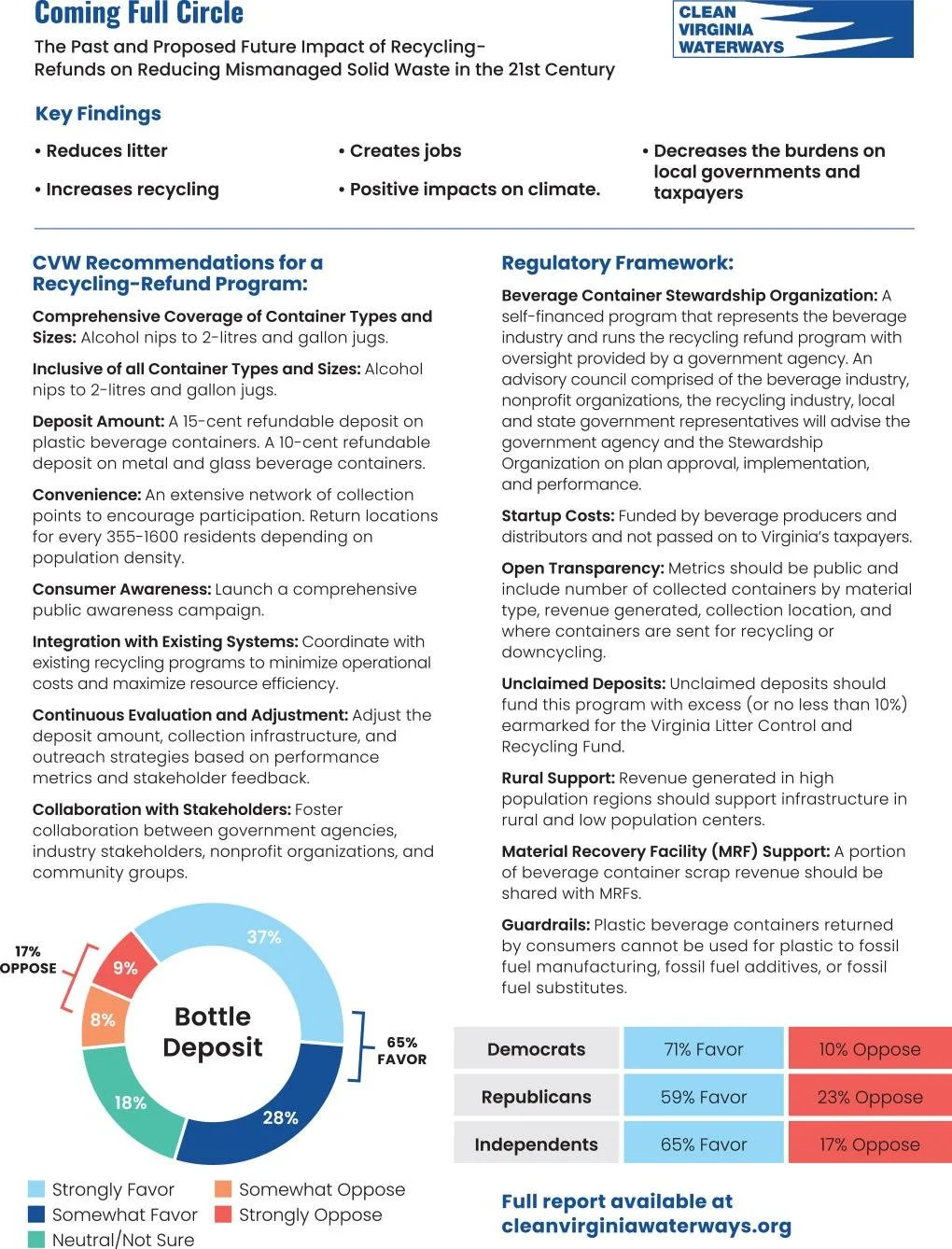
Learn the Facts:
Bottle Bill.
What is a Bottle Bill?
A recycling-refund program, often called a bottle bill, sets up an incentive for beverage containers to be recycled. When someone buys a packaged drink, whether in a can, a plastic bottle, or a glass bottle, they pay a small deposit (typically $0.05-$0.15). After finishing the beverage, they can return the container for recycling at the point of purchase or a redemption center and get their deposit back. This type of program has existed for decades in multiple US states, and has been shown to decrease littered beverage containers - one of the most commonly littered items found in streamside and roadside cleanups.
Similar terms all refer to the same concept:
Recycling-refund program
Bottle bill
Container deposit law (CDL)
Deposit-refund scheme
Read on for more details about how a beverage container recycling-refund program can help Virginia reduce litter, promote recycling, add jobs, improve the climate, and lighten the load on taxpayers.
VA Beverage Recycling-Refund Policy Outlook Report
This Clean Virginia Waterways report released in May 2025 explores how recycling-refund systems, often referred to as "bottle bills," have been shown to reduce litter and waste. The report outlines the potential for such a program in Virginia to dramatically cut plastic pollution and mismanaged solid waste.
Key Report Findings
Increases Recycling
Charging deposits on frequently littered items gives consumers an immediate economic incentive to return containers for recycling.
It also provides recycling companies a consistent, predictable, clean, and ongoing “input” for their business.
Increasing recycling also provides more post-consumer material for manufacturers so they can meet their goals of increasing recycled materials in their products.
Positive Climate Impacts
From a purely environmental standpoint, recycling-refund programs can help to reduce energy use as well as greenhouse gas emissions.
Such programs promote increased reuse of plastic, aluminum, and glass, all of which help to save energy by following a more circular economic model, rather than following the linear extraction-manufacture-use-discard trajectory that characterizes so much of our economy. The program provides a reliable source of scrap material, or post-consumer resin (PCR) for producers to use in the production of new goods.
Reduces Litter
Recycling-refund programs for beverage containers like plastic and glass bottles and aluminum cans help reduce litter.
This is clear when comparing states with these programs to those without them. In states with refund programs (except Iowa and Vermont), drink containers make up about 6.29% of litter. Meanwhile, in the states studied without these programs, the number is much higher: about 14.89%.
In Virginia, 16.78% of litter in 2022 came from beverage bottles and cans. This shows that a refund program could be an effective way to cut down on this type of litter.
Creates Jobs
Recycling-refund programs can boost job creation, as workers are needed to collect and process an increased volume of returned beverage containers.
For example, more than 5,000 new jobs have been created in Michigan following the establishment of the state’s recycling-refund program, thanks to the accompanying infrastructure and logistics required to run the program.
Reduces Local Burden
Recycling-refund programs create a new, effective, and organized waste stream for beverage containers, which are highly consumed and frequently littered.
This new waste stream reduces burdens on local governments and taxpayers by decreasing the amount of solid waste going to landfills. Alleviating masses of beverage containers allows for better functioning of landfills, focusing on materials that have no other option than going to a landfill.
It is important to note that recycling-refund programs place more of the economic burden of beverage container litter on consumers of these products, rather than taxpayers who are forced to clean litter up after the fact.








